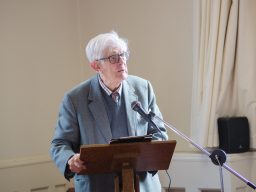
Hugh Dickinson
by The Very Revd Hugh Dickinson
The Epistle to the Hebrews is a source of considerable unease to many Christians.
It sets out to demonstrate to newly converted first century Jewish Christians that the elaborate ceremonial rituals of Temple worship outlined in the Pentateuch can provide a key to interpreting the true meaning of the sacrifice of Christ. This unease is due to the implicit assumption that the death of Jesus is part of divinely ordered sacrificial mechanisms involved in negotiating the spiritual interface between the all-holy Creator and his wayward people. The more valuable the sacrifice the greater potency it has. The impressively complex and imaginative catalogue of parallels drawn by its author between the Old Order of Scripture and the New Order of the Spirit is a beautiful tour de force, but it has had a disproportionate gravitational pull on subsequent theological reflections, and is too obscure for most ordinary Christians who seldom refer to it.
Hebrews is a highly sophisticated example of the almost universal rituals of the sacrifice paradigm in the ancient world which originally involved human sacrifice, as has been amply demonstrated by the recent archaeology of the early South and Central American civilisations. There are also traces of it in European and Eastern cultures. The strange episode of Abraham’s aborted sacrifice of Isaac related in Genesis marks a change of paradigmatic rituals: valuable animals can be substituted for precious humans.
But echoes of the custom can be found even in the 20th century. In C.S Lewis’s Narnia fantasy world, we learn that the death of Aslan the Lion can be reversed by a secret provision, or recipe, in the founding laws of the Narnia world, which enables the willing self-sacrifice of a semidivine agent to set free the prisoners of the wicked White Witch. Perhaps it is only grumpy old pedants who will ask: who was it that ordained the unwritten foundational laws of Narnia?
Clearly Aslan is a symbolic Jesus figure in the myth. But that myth also has echoes of the later Honour Paradigm. In the Middle Ages, theologians used the complex cultural mechanisms of the feudal system to illustrate the meaning of the death of Jesus. The feudal “honour” system, which still persists in a number of Islamic cultures, provides a graded tariff of offences and penalties, a tariff which is also reflected in the limiting legal tariff of the “eye for an eye and a tooth for a tooth” provisions of the Pentateuch, in order to avoid endless honour feuds. The honour system also provides for the possibility that someone else could pay the penalty to the injured party on behalf of the offender, a provision which resulted in the distortions of “substitutionary” theologies of the Cross. The feudal recipe provided that the greater the injury to the honour of the offended party the more valuable the recompense that must be paid. God’s transcendent honour has been offended by human sin, so only a transcendent penalty can balance it; only the sacrificial death of the Son of God can pay for human sin. It took brave commentators centuries later to point out that feudal Europe was a poor exemplar for a persuasive Christian theology. Nevertheless it persists in many of the 19th Century passion-tide hymns we still sing.
No social or cultural convention or custom can provide a plausible model for the deeply mysterious transaction which underlies the events of Christ’s death and resurrection. All the options look more like chemical formulae or the rules of a game. Different cultures play different games. The rules of rugby and football were evolved over a period of several decades; they can be changed, but only with great difficulty and after much heated disputation. No one knows who wrote the rules of Contract Bridge, but once they were formulated it is as if the rules are engraved in steel. Games players cling on to their rules tenaciously because, though they do have flaws, they work well enough for most participants. The “Game” Paradigm is unobtrusively at work in many popular cultural activities.
Christian doctrines embodying “games” theologies of the Atonement can only work as long as they are held by a large majority of the the Christian Church. When the doctrinal rules or images are losing conviction members will start voting with their feet. So for many 21st century Christians, the 19th century paradigm has almost lost its traction. Vatican II is a symptom of a paradigmatic wind of change. Any analogy for the meaning of the death of Jesus Christ is inevitably vulnerable to the possibility of revision in the light of changing cultural paradigms or disputable social norms, customs or laws. The same is true of a fundamentalist reading of Scripture: it is a mechanistic myth which fails the test of rationalism that is the dominant Enlightenment paradigm in the West. Do we need any model to understand the paschal mystery? Can we not explain it with the usual political, social, psychological and spiritual terms we use to describe any historical event? Or is that just a covert way of hiding a newly emerging paradigm?
Do we need any model to understand the paschal mystery? Can we not explain it with the usual political, social, psychological and spiritual terms we use to describe any historical event? Or is that just a covert way of hiding a newly emerging paradigm?
Such a historical approach affirms that from infancy Jesus was deeply (uniquely?) sensitive to the presence of an all-enfolding divine personal love. He communes constantly with the One he calls “Abba”, or Father; as he grows and matures he himself becomes a living embodiment of the personality and character of the Divine Agency which enfolds and guides him. At the crucial turning point of his life, his baptism by John The Baptiser, he feels impelled to begin actively engaging with the ailments of the systemically oppressive cultural, religious and political structures in his immediate social environment, which for him are clearly contrary to the true purposes of the Abba Father, which Jesus calls “God’s Kingdom”. For three years his words and actions gathered massive support among the impoverished and oppressed people of the land “who heard him gladly”. With a programme of spectacular healings and public challenges to the corrupt and oppressive political and religious regime of the Temple authorities in and their apostasy in their collusion with Imperial Rome, (“We have no king but Caesar”) he demonstrates what the sovereignty of God could mean in practice. His challenge was religious and, in the ancient world, inevitably political. The Gospels tell us that before long Jesus realised he was on a collision course with the Temple authorities, and that if he persisted, it would certainly lead to his death. But his deep commitment to the Kingdom meant that he had to be obedient to Abba’s leading wherever it took him. The crisis came in the week leading up to the great festival of Passover. We have no way of knowing exactly how Jesus expected the drama of his confrontation with the Temple authorities would unfold, but it would surely be a public debacle in the middle of the Passover festivities, when the religious apostasy of the Temple priests would be publicly exposed. In the event he was betrayed by one of his closest friends and strung up to die on the civic gallows. His dying words are agonisingly poignant, “ My God! My God! Why have you abandoned me”. He died believing his mission had failed. Abba God had failed him.
Three days later he appears to his friends very much alive and as a living proof that his Kingdom mission had not failed. By sacrificing his life in obedience to his Father’s will he has opened a gateway through death for all his followers to join in his Kingdom campaign in the power of the Spirit, the Spirit which he breathed into them as they gathered in the upper room on Easter evening. The risen Jesus is in himself the unfolding of the Paschal mystery and its permanent protagonist wherever baptism and the Eucharist are celebrated. Christ is himself the new paradigm of the revolutionary polity of Christ’s kingdom which is now carried forward under the impetus of the Resurrection. No other explanatory Atonement mechanism is needed. His followers were still happy enough to use the ancient biblical word “ransom” to describe the saving power of his death and resurrection to rescue every human being from the prison of death’s domain in the past and now into the future – without asking to whom the ransom was paid.
This explanation of the Jesus Event requires no analogies or metaphysical mechanisms. The only assumption Christians make is that Jesus was an authentic and credible witness to the reality of any personal engagement with God, and that the gospels are credible witnesses to the reality of the Resurrection event, even if we cannot be sure exactly what it was.
The dilemma which confronts us is the key issue raised by all philosophies seeking to give a credible account of these witnesses to the universal personal consciousness of the realm of the transcendent. A key instance of that is the reality or “truth” of the “Jesus event” and the subsequent global witness of the evolving paradigmatic traditions issuing from it. Of course if we conclude that Jesus was deluded there is no firm ground for any spiritual or philosophical discourse. But in among the New Testament’s bricabrac there are many nuggets of pure gold and eternal diamonds: enough to crown a new style universal “King of Glory”.
It is now clear why totalitarian regimes are so hostile to the Christian religion just as the Roman emperors were. Dictators assume divine authority even over the hearts and souls of all their subjects. That is why they hate music and abstract art and jokes.
President Xi soon will start an atheistic programme of systematic elimination of all religions. That is also why Jesus says he has come to set all humankind free.
===
The Very Revd Hugh Dickinson was Dean of Salisbury Cathedral from 1986 until his retirement in 1996. Through his leadership and vision, governors and trustees founded Sarum College in 1995, a year after the closure of Salisbury & Wells Theological College. The photo of Hugh was taken during his address to mark Sarum College’s 20th Anniversary in September 2015 (ashmills.com).

Leave a Reply